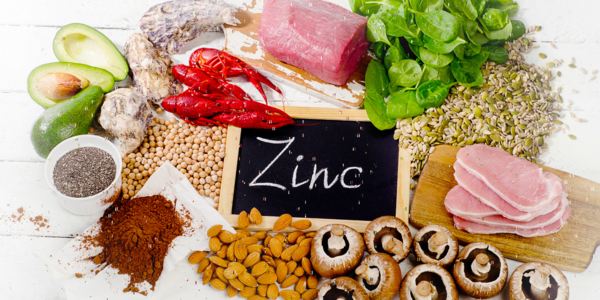|
Many of us know that zinc is required at adequate levels to have a healthy immune system. But did you know that adequate levels of zinc are also required for wound healing, collagen formation (hello healthy hair, nails and skin!), and even hormone production? Zinc is also required to convert vitamin A into its active form which is required for proper vision, especially at night. Although a blatant zinc deficiency is rare in the United States (it is estimated that approximately 10% of the adult population in the US is deficient), studies have shown that zinc loss through urine increases by 10-45% after moderate exercise. Zinc, like many of the other minerals we have been discussing this month, is also lost in sweat. With many athletes' diets being low in mineral density and an increased rate of mineral loss during exercise, it is no wonder why we see thousands of reported clinical trials and studies devoted to exercise performance and mineral status. And the findings are clear. Magnesium, zinc, calcium, copper, and iron appear to be the leading minerals impacted by exercise, with magnesium and zinc impacted the most. Zinc is a key micronutrient for proper cell division and cell growth, so it’s needed to maintain strength in the muscular and skeletal systems. It also helps with the release of growth hormone, testosterone and insulin-like growth factor-1, all of which build muscle mass and help you maintain a healthy metabolism. Zinc deficiency has been shown to lead to chronic fatigue and low energy levels because it is a key nutrient when it comes time to absorbing both protein and carbohydrates from our food. There is no question about the increased needs for minerals in athletes, especially zinc. So let’s take a closer look at the signs of deficiency, risk factors, some real food options for optimizing uptake, testing and even best supplementation practices. SIGNS OF DEFICIENCY Usually the first sign of a zinc deficiency is in the skin. It is not uncommon to see patches of dry skin that lead into acne and/or blisters if the deficiency isn’t resolved. Other more severe signs of zinc deficiency include:
RISK FACTORS Vegans and vegetarians are at higher risk for being zinc deficient because the majority of zinc in our diet is found in animal products. There are many plant based foods that contain zinc, but the bioavailability of the zinc is quite low. This is because of the plant's natural chemical protector, phytic acid. Phytic acid binds to zinc and reduces it’s absorption in the intestines. Athletes and those that sweat a lot are also at a higher risk for a zinc deficiency because zinc is lost in sweat. Both inflammation and poor absorption in the digestive tract are also common reasons of zinc deficiency. Therefore, if a zinc deficiency is suspected, both digestive health and overall inflammation should be looked into. Interestingly, low zinc status has also been shown to affect PMS symptoms in menstruating women. A small study which measured blood levels of zinc and copper in 10 PMS patients (compared to 10 women without PMS, aka the controls) found that zinc deficiency occurred in PMS patients during the luteal phase (typically days 15-28 of your cycle). Although this study was small, the differences found in zinc levels in the PMS patients compared to those who did not experience PMS during the luteal phase were significant. When zinc is not present in adequate levels pre-menstruation, it is not uncommon for women to experience cravings. If this is you, try adding more zinc into your diet from days 15-28 of your cycle and see if the food cravings reduce and/or disappear. For a list of foods that can help you identify which nutrients you may be low in, check out my free food cravings list available HERE. TESTING The most reliable way to know if you have enough zinc is with a plasma zinc test. It is critical to measure zinc in the plasma, rather than the serum. Functional ranges for a plasma zinc test should be between 100-120 mg/dL. Alternatively, if a blood test is not possible, you can do a zinc taste test (and I HIGHLY recommend doing this!). The zinc taste test is an easy, inexpensive, at home testing method to assess zinc status based on studies of taste and smell. To do this test, you will need 5-10mL of aqueous zinc (like Zinc Tally from Metagentics). Here is how it’s done. Place approximately 2 teaspoons (10mLs) of aqueous zinc in your mouth and hold for 30 seconds. Describe your initial taste according to the following categories (for accurate results, refrain from eating, drinking or smoking for at least one hour prior to the test): Response 1: No specific taste or other sensation is noticed after the solution has been held in the mouth for up to 30 seconds. This strongly suggests a zinc deficiency and foods rich in zinc and zinc supplementation should be considered. Response 2: No immediate taste is noted, however, after a few seconds a slight taste develops, variously described as “dry”, “mineral”, “furry”, “sweet”. This suggests a zinc deficiency and foods rich in zinc and zinc supplementation should be considered. Response 3: Definite, though not strongly unpleasant taste is noted almost immediately and tends to intensify with time. This suggests that zinc is likely inadequate and a strong focus on increasing zinc rich foods and it’s cofactors is strongly suggested. Response 4: A strong unpleasant taste is noted almost immediately. This suggests that zinc status is sufficient and no zinc supplementation is needed. The liquid can be swallowed or spit out once the test is completed. FOOD SOURCES Zinc is most abundant in animal based foods, such as oysters, grass fed beef, lamb and cheese. There are many plant based foods that contain zinc, but due to high phytate content in those foods, the zinc has a low bioavailability. Soaking your nuts, seeds and grains prior to consumption can help decrease the phytic acid and increase bioavailability to the zinc. Therefore, if you are relying on plant rich sources of zinc, be sure to soak your grains, nuts and seeds first. The recommended daily allowance (RDA) of zinc is 15 mg for a healthy adult. You can easily get your daily needs by eating any of the following food:
SUPPLEMENTS As with all other vitamins and minerals, optimizing the diet with zinc rich foods, addressing any chronic inflammation and optimizing digestion should always be your first steps to address any deficiencies. If after these have been addressed, a zinc deficiency is still suspected, consider supplementation. Always talk to your doctor about taking any over the counter supplements to ensure they are safe for you and will not interact with any other medications. According to Chris Masterjohn, PhD, zinc acetate, gluconate, sulfate, citrate, or methionine should be used when supplementing with zinc, and not zinc oxide or zinc picolinate. Ideally, zinc should be taken on an empty stomach, but if this causes nausea it should be taken with some food and should be taken as far away from phytate-rich meals as possible. The zinc should be spread out as much as possible to ensure better absorption. For example, 15 milligrams three times per day five hours apart is much better than taking 45 milligrams once per day. Zinc supplementation higher than 45mg per day should never be used unless under medical supervision. Excess zinc consumption can cause a copper deficiency as they compete for the same receptors in the body. IN SUMMARY Zinc is a mineral that is found in every single tissue of the body and it plays a role in hundreds of different reactions in the body. Majority of sedentary people are consuming enough zinc in their diet, but athletes have been shown time and time again to have mild to severe zinc deficiencies. According to a study published in Sports Medicine in 2001, endurance athletes who follow a higher carbohydrate, lower protein and lower fat diet often leads to suboptimal zinc intake in 90% of those athletes. Mild zinc deficiency can be difficult to detect because of the lack of definitive indicators of zinc status. This can put athletes at risk for reduced endurance, loss of muscle mass and at greater risk of stress fractures. Zinc deficiency has been shown to reduce muscle strength and power, so inadequate zinc levels could affect performance during exercise. The bottom line is you need to get tested. If a plasma blood test is out of the question, get your hands on aqueous zinc and do your own at home zinc taste test. You don’t want a mineral deficiency hurting your overall health or athletic performance! REFERENCES: 1. https://draxe.com/nutrition/foods-high-in-zinc/ 2. Chuong and Dawson, Zinc and copper levels in premenstrual syndrome, FERTILITY AND STERILITY, Vol. 62, No.2, August 1994 3. Sports Med. 2001;31(8):577-82.doi: 10.2165/00007256-200131080-00002. Zinc status in athletes: relation to diet and exercise. A Micheletti, R Rossi, S Rufini
0 Comments
Leave a Reply. |
AuthorTiana Rockwell is a certified nutritional therapist, avid endurance athlete and dark chocolate lover. She believes that by eating REAL food, we can balance our body and reach optimal health and wellness! Archives
May 2022
Categories
All
|






 RSS Feed
RSS Feed